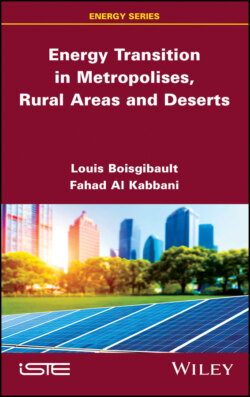Читать книгу Energy Transition in Metropolises, Rural Areas, and Deserts - Louis Boisgibault - Страница 16
1.3. The importance of climates in the energy transition
ОглавлениеGeographers insist on the heterogeneity of climates (Godard and Tabeaud 2009) on the surface of continents and oceans, on their spatial discontinuities, on their seasonal rhythms and on their interannual variabilities. The main measurable atmospheric parameters are defined and characterized in their spatial distribution and seasonal variability. To compare climates here, the scale of Wladimir Köppen (1846–1940) was used. It is based on precipitation and temperature and dates back to 1900, with an update in 1961 by Rudolf Geiger, who explains that the climate map is called Köppen–Geiger. The classification consists of three letters that associate a climate code with a precipitation code and a temperature code. The five possible codes for major climate families are as follows:
– A: tropical climate;
– B: dry conditions for Saudi Arabia, Senegal and Morocco;
– C: temperate climate for France;
– D: continental climate;
– E: polar climate.
In addition, there is a second letter for the rainfall regime with:
– W: very low desert rainfall for Ouarzazate and Saudi Arabia;
– S: dry season in summer for the French Riviera and Senegal;
– F: wet and rainfall every month of the year for Lille.
Other rainfall classifications, such as monsoon climates and heavy rainfall, are not applicable to the selected sites.
The third letter finally specifies the amplitude of the annual temperature cycle with:
– a: hot summer for the Côte d’Azur: average temperature of the hottest month >22°C;
– b: temperate summer for Lille: average temperature of the hottest month <22°C and average temperatures of the four hottest months >10°C;
– h: dry and hot for Senegal, Morocco and Saudi Arabia: average annual temperature >18°C.
Other temperature variation classifications, such as very cold winters, are not applicable to the selected sites.
This exercise shows that, for the land selected:
– not all terrestrial climates are covered, including tropical (A), continental (D) and polar (E) climates;
– the desert climate of Ouarzazate is similar to that of Saudi Arabia (BWh);
– the level of low rainfall in the Pays de Fayence is similar to that of Bokhol in Senegal (S).
Table 1.3. Climate in the selected areas according to the Köppen classification
| European metropolis of Lille (France) | CFb |
| Pays de Fayence (France) | Csa |
| Ouarzazate (Sahara Desert, Morocco) | BWh |
| Neom (Saudi Arabian Desert) | BWh |
| Riyadh (Saudi Arabia) | BWh |
| Bokhol (Senegal) | BSh |
Riyadh and the Sahara Desert, which are at the level of the Tropic that crosses 18 countries, do not have a tropical climate for all, because of the important continental mass.
The energy sector is heavily impacted by the climate, which conditions living habits for housing, transport and industrial practices. Mastering climate data makes it possible to better estimate the energy production required to enable consumption. Good prediction of meteorological variability has a direct influence on the supply–demand balance of electricity, on the planning of plant maintenance operations and on the risks associated with extreme weather events.
Similarly, the energy sector is a major emitter of greenhouse gases, due to the very significant industrial installations in all components of the sector’s value chains. Carbon dioxide (CO2) is the main gas, along with water vapour (H2O), which is emitted. Its concentration in the atmosphere is measured by the World Meteorological Organization (WMO) in particulate matter per million (PPM) and exceeded 415 PPM at the end of March 2019, an increase of 48% compared to 1,750 (280 PPM). This concentration inexorably increases each year through new emissions and is insufficiently reduced by the absorption of CO2 by the oceans and forests. The development of urbanization tends to destroy these carbon sinks, which are important to preserve. In addition to CO2, we must not forget the emissions of methane (CH4), nitrous oxide (N2O) and about 40 other gases identified by the IPCC, less concentrated in the atmosphere but sometimes more harmful.
In its “New Policies”2 scenario, the International Energy Agency estimates that energy-related CO2 emissions will continue to increase until 2040. This trajectory is problematic in terms of meeting the commitments made at COP21 for the Paris Climate Agreement. It is incompatible with scientific recommendations to combat climate change and with the commitment to stabilize global warming due to human activities below 2°C by 2100 (compared to pre-industrial temperature) by strengthening efforts to reach the 1.5°C target.
